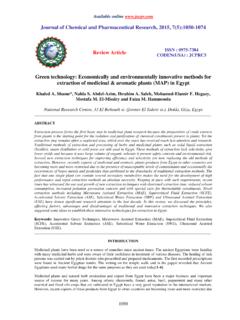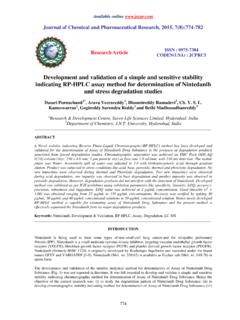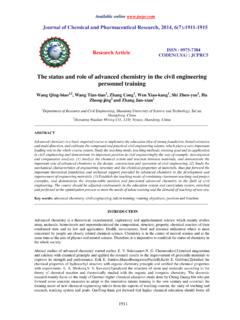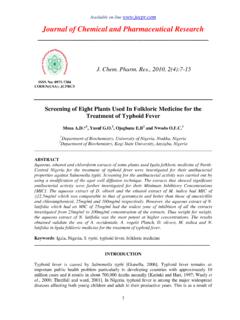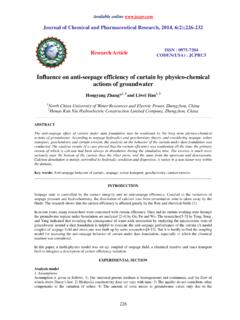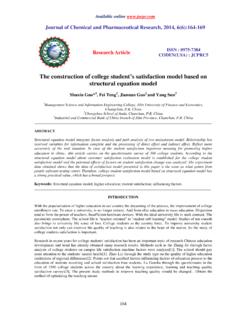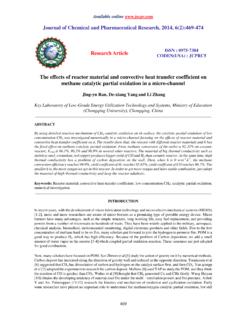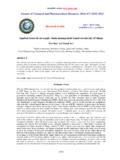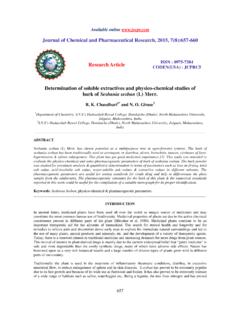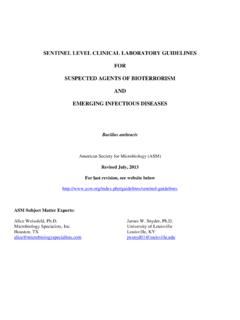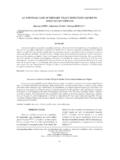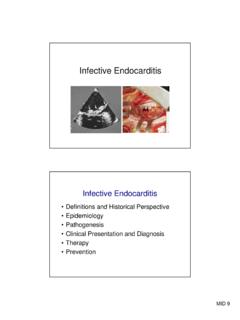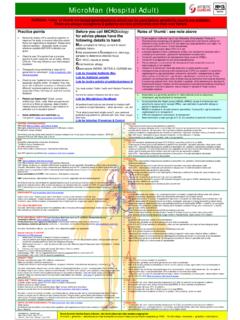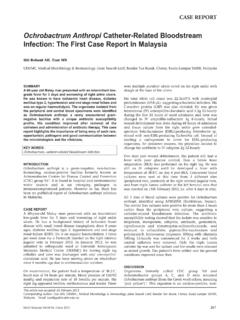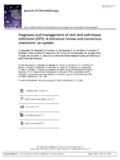Transcription of Research Article ISSN : 0975-7384 CODEN(USA) : …
1 Available online Journal of Chemical and Pharmaceutical Research , 2015, 7(2):872-875 Research Article issn : 0975 - 7384 coden (USA) : JCPRC5 872 Evaluation of the antibacterial activity of the extracts of the whole plant of Orthosiphon thymiflorus (Roth.) Sleesen Mercy Lavanya , Gnanamani and Ilavarasan * 1 Captain Srinivasa Murti Research Institute for Ayurveda and Siddha Drug Development (CCRAS, Ministry of AYUSH, Govt. of India), Anna Hospital campus, Arumbakkam, Chennai 2 Department of Microbiology, Central Leather Research Institute, Adyar, Chennai _____ ABSTRACT Orthosiphon thymiflorus is a medically important plant known for its various pharmacological properties.
2 In the present study the successive extracts of the whole plant of O. thymiflorus was evaluated for their antibacterial property against 11 bacterial strains, of which 10 were clinical isolates and 1 a typed culture. The clinical isolates used for the study were Escherichia coli, Staphylococcus aureus 2 different strains, Proteus mirabilis, Salmonella typhi, Salmonella paratyphi B, Klebsiella pneumonia, Pseudomonas aeruginosa, methicillin sensitive Staphylococcus aureus and methicillin resistant Staphylococcus aureus from a clinical laboratory and Staphylococcus aureus NCIM 5021 from National Chemical Laboratory, Pune.
3 Well diffusion technique was employed to screen for the activity. MTT assay was used to study the MIC and MBC was also tested. The alcohol extract was found inhibit 7 strains of the 11 strains tested. MRSA was also inhibited. The MIC and MBC was found to range between to mg. Keywords: O. thymiflorus, well diffusion method, MIC, MBC, MTT assay _____ INTRODUCTION Plants have not only been a source of food but also as remedies to both acute and chronic illness. There are a lot of drugs from plant origin that have helped mankind combat sickness. Atleast 120 distinct phytochemicals are now considered as important and are currently in use in one or more countries in the world [1].
4 The lamiaceae are a family of flowering plants represented with about 220 genera and more than 4000 species worldwide [2]. Orthosiphon is a genus in the family Lamiaceae containing about 40 species. The species of the genus occur mostly in the Old World tropics, South Africa, Madagascar and the tropical and sub-tropical Asia [3]. The species are annual or perennial herbs with a woody root stock found in Eastern and Western Ghats of India. The plant has a variety of pharmacological activities like anti-diarrhoeal, antipyretic, wound healing, diuretic and antioxidant [4]. Antimicrobial resistance (AMR) threatens the effective prevention and treatment of an ever-increasing range of infections caused by bacteria, parasites, viruses and fungi.
5 It is an increasingly serious threat to global public health that requires action across all government sectors and society. AMR is present in all parts of the world. New resistance mechanisms emerge and spread globally. This worldwide increase of multidrug resistance in both community- and health-care associated bacterial infections has impaired the current antimicrobial therapy, warranting the search for other alternatives. This study was aimed to find the in vitro antibacterial activity of the n-hexane, chloroform, ethyl acetate and alcohol extracts of the whole plant of Ilavarasan R. et al J. Chem. Pharm. Res.
6 , 2015, 7(2):872-875 _____ 873 EXPERIMENTAL SECTION Extraction of the plant The plant Orthosiphon thymiflorus (Roth.) Sleesen was collected from Kurumalai, Thuthukudi District in the month of December. The plant was authenticated by Prof. P. Jayaraman, Director, Institute of Herbal Botany, Plant Anatomy and Research centre, Chennai 600045, based on the organoleptic, macroscopic and microscopic examination of fresh sample. The specimen voucher is PARC/2013/2187. The shade dried plant material was chopped into small pieces and made into coarse powder. The plant was successively extracted with n-hexane, chloroform, ethyl acetate and alcohol extracts using Soxhlet apparatus [5].
7 50 g of the plant material yielded 250 mg of n-hexane extract, 550 mg of chloroform extract, 400 mg of ethyl acetate extract and 450 mg of alcohol extract. Antibacterial Activity of (Roth.) Sleesen. The extracts of the whole plant of were tested against 11 strains of bacteria, 1 typed strains and 10 clinical isolates. The typed strain, Staphylococcus aureus NCIM 5021 (NCIM National Collection of Industrial Microorganisms), was procured from National Chemical Laboratory, Pune and maintained by serial subculturing on to Nutrient agar slants. The clinical isolates Escherichia coli, Staphylococcus aureus 2 different strains, Proteus mirabilis, Salmonella typhi, Salmonella paratyphi B, Klebsiella pneumonia, Pseudomonas aeruginosa, methicillin sensitive Staphylococcus aureus and methicillin resistant Staphylococcus aureus were obtained from a clinical laboratory.
8 Was the only Gram positive organism used in this study, the rest were Gram negative organisms. Well cut method [6] was employed. Norfloxacin 10 mcg was used as standard for Gram negative organisms and gentamicin 10 mcg was used as standard for Gram positive organisms. 10% Dimethyl sulphoxide (DMSO) was used as vehicle. 40 mg of each extract (n-hexane, chloroform, ethyl acetate and alcohol) was weighed and mixed with 500 l of 10% DMSO separately to form a homogenous mixture. The organisms were inoculated as lawn culture on Mueller Hinton agar plates and well of 6 mm was cut equidistant with sterile plunger. 25 l of each extract in DMSO were transferred into separate wells.
9 10 l of 10% DMSO was added to one well as negative control. The standard antibiotic disc was placed as positive control. The plates were incubated at 37 C for 24 hrs and the zone of inhibition was measured in mm. MIC was determined for the organisms that were found to be sensitive to the extracts. Minimal Inhibitory Concentration (MIC) of extracts was determined using the microdilution bioassay. Overnight cultures of the bacteria that were found sensitive to the extracts were diluted with sterile Mueller Hinton Broth to give a final inoculum concentration of 105 cfu/ml. Six different concentrations of the extracts were employed for the study.
10 50 l of each bacterial culture were added to each well of a 96 well microtitre plate. The extract was added in different concentrations. The plate was covered with parafilm and incubated at 37 C for 24 hr. Bacterial growth was detected by adding 50 l of mg/ml p-iodonitrotetrazolium chloride (INT) with further incubation of 2 hrs. The colourless tetrazolium salt is biologically reduced to a red product by viable bacterial organisms. MIC values were recorded as the concentration in the last wells in which no colour change was observed after addition of INT [7]. Minimum Bactericidal Concentration (MBC) was determined by selecting tubes that showed no growth during MIC determination; a loop full from each tube was sub cultured onto Muller Hinton agar plates and incubated for further 24 hours at 37 C.
